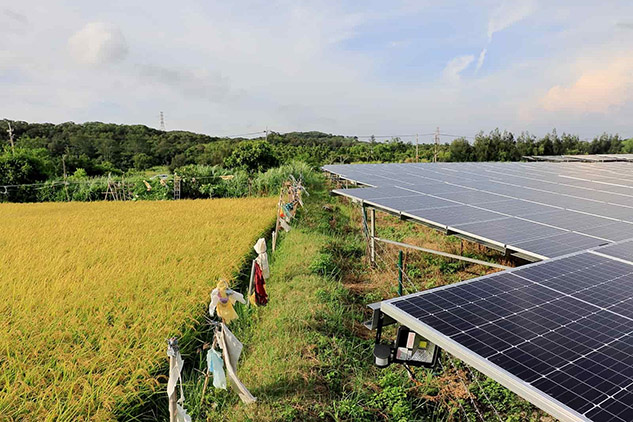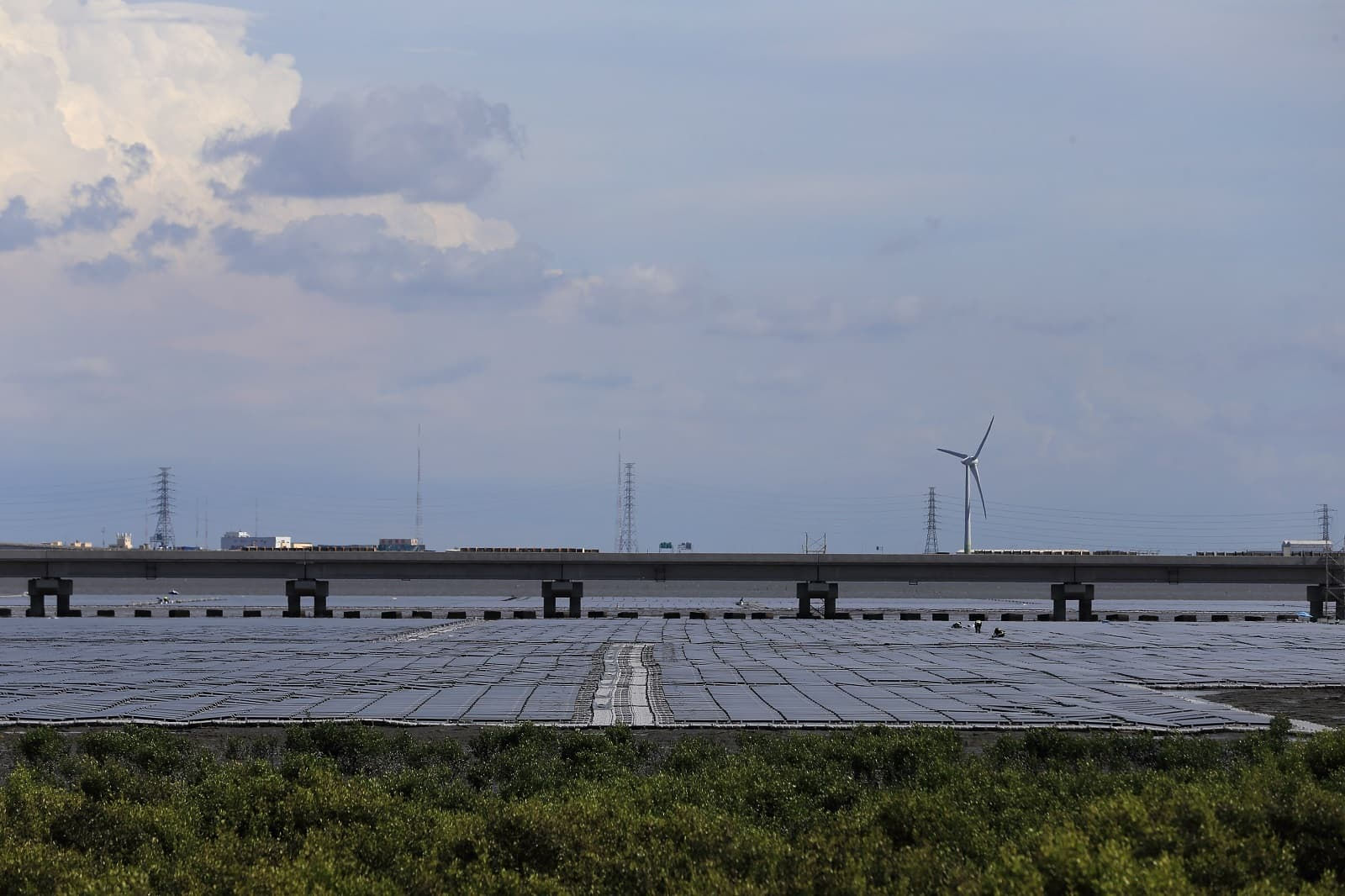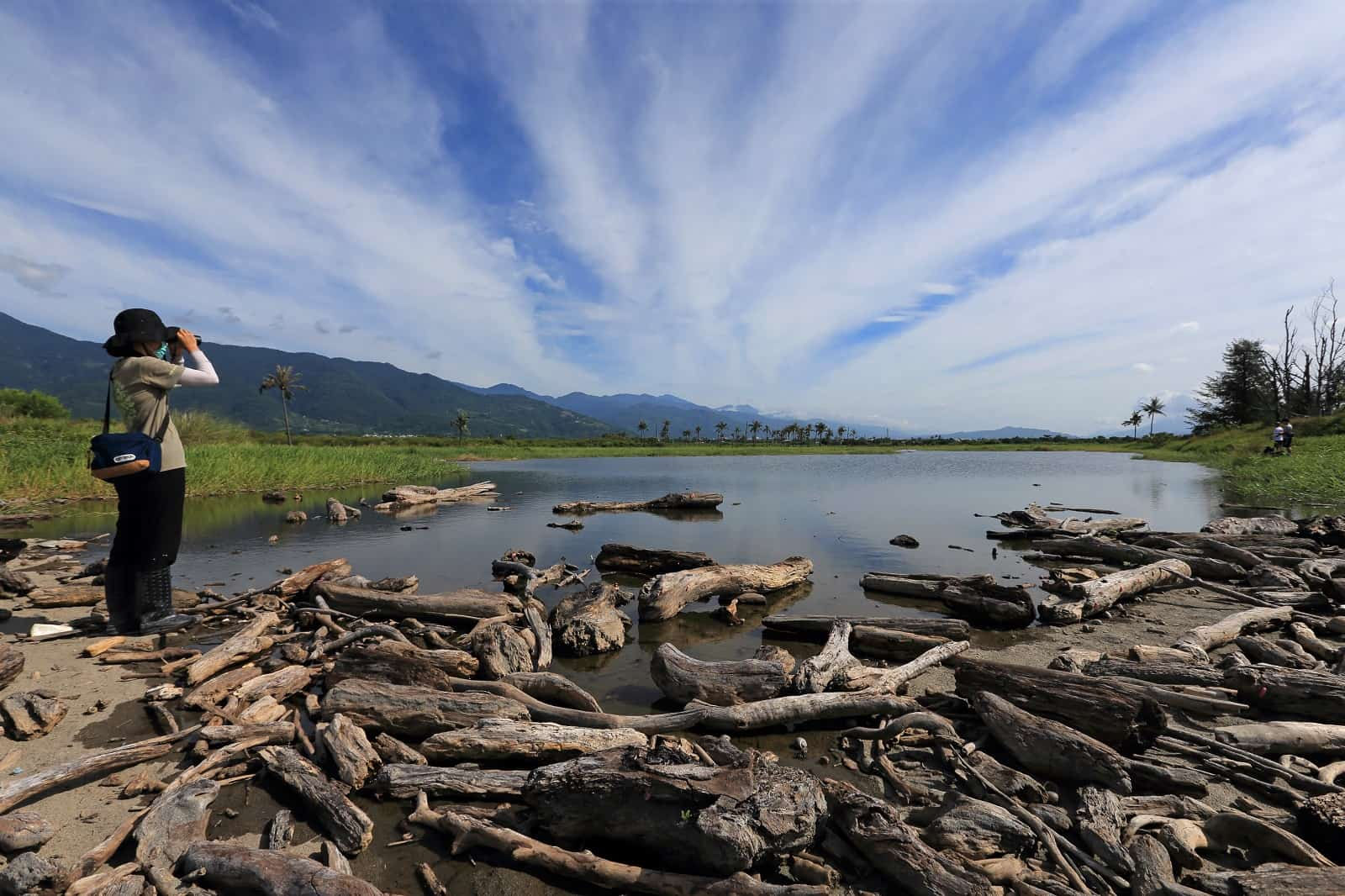Taiwan’s Solar Power Dream Collides with Reality

Source:Chien-Ying Chiu
Taiwan’s solar power policies are threatening the environment by putting pressure on coastal ecosystems and wild animal habitats and turning power plant land and licenses into mere financial commodities. What has gone wrong?
Views
Taiwan’s Solar Power Dream Collides with Reality
By Kuo-chen Luweb only
Head south in the Changhua Coast Industrial Park’s Xianxi Section and a big lagoon and large expanse of wetlands will suddenly appear, with fishing boats lazily gliding on the water. A bright light flashes on the horizon, generated by solar panels.
What one sees is the industrial park’s Lunwei East section, a zone designated by the Ministry of Economic Affairs (MOEA) as Taiwan’s first green energy area. It has two main goals: revive the idle industrial park lands and develop solar power.
Ultimately, the government hopes the area can emerge as a key contributor to the goal of installing 20 GW of solar power capacity (able to produce about 1.25 times the electricity that would have been generated by the now-mothballed fourth nuclear power plant) by 2025.
In fact, the Lunwei East area is a wetland and lagoon directly connected to the sea. At high tide, the area morphs into a vast ocean, allowing fish and shrimp to swim into the lagoon and even fishing boats to sail in. When the tide recedes, an intertidal zone appears.
This fragile ecosystem is at the heart of a controversy over the Lunwei East area project, and typical of the environmental forces dogging other solar initiatives around Taiwan. CommonWealth has identified three major types of controversies holding back solar power development.
Controversy 1: Rezoning Allowed without EIA
When Taiwan’s central government planned the development of the Changhua park, located along the western coast of central Taiwan, the Lunwei East section was zoned for industrial use. But because the park’s land reclamation project has yet to be completed, it is currently classified as intertidal land that is submerged in water at high tide and dry at low tide, and is zoned as “Type D building land.” That means it can be used to build factories or install solar panels without having to do an environmental impact assessment or an ecological survey.
The distinction is critical because this is where the MOEA is planning to locate the world’s biggest floating solar array. The MOEA’s vision, which will require an estimated NT$16.3 billion in investment, involves solar panels covering an area of 347 hectares in the intertidal zone to get 320 MW of installed capacity and generate an amount of electricity similar to that of a mid-sized coal-burning plant.
The first to invest in the project was solar energy platform Chenya Energy, owned by U.S.-based I Squared Capital at the time (but later sold to Japan-based Marubeni Corporation). It received a loan of NT$7.2 billion from a consortium of international and local banks to finance the construction of a 180 MW of floating solar power capacity.
When the first phase of construction was completed, the ecological dilemma became evident: Chenya’s photovoltaic modules use pontoon-type floats. The modules float on the water when the tide is high enough, but at low tide the solar panel pontoons press against the ground. What the potential impact on organisms might be, nobody knows because no environmental impact assessment or ecological survey has been done.
Hung Cheng-chung (洪正中), head of the Taiwan Environmental Righteousness Association (TERA), launched a petition to oppose the project. “Green energy is something everyone is hoping for, but you can’t hurt agriculture or destroy the environment,” Hung said.
Solar power development has also been something of a sore spot in Tongxiao Township in Miaoli County.
Pointing to hillside land in the township, Leopard Cat Association of Taiwan board director Lee Ching-hung said more than 3,000 grey-faced buzzards arrive in the area every March to rest, feed and regain their strength. They then fly north to return to their homes. The area also serves as the habitat for the leopard cat and other wild animals.
Starting last year, several patches of land in the area were cleared to install solar panels, with many of them plots of agricultural or forest land of under two hectares located near roads. For land that meets those requirements, people can apply to the commerce departments of local governments to change the zoning of the land and install solar panels without being subject to any ecological assessment. Today, there are more than 100 such applications still pending in Miaoli County.
Lee is worried because none of these solar power installations have undergone ecological assessments, they used pesticides to clear vegetation, and no ecological corridor was planned to allow leopard cats and other wild animals pass through safely.
“I’m not opposed to solar power, but you should consider the environment and wild animals and act sustainably,” he said.
Then there’s eastern Taiwan’s biggest solar energy project, Vena Energy’s project in the hot springs resort town of Zhiben in Taitung County.
The project is located in an alluvial plain at the mouth of the Zhiben River. Society of Wilderness chairwoman Liu Yueh-mei described the spot as the biggest marsh wetlands on the east coast and a corridor through which migratory birds have to pass. Its dazzling variety of landscapes, from water basins, beaches, and coastal forests to coastal vegetation belts, shrubs and grasslands has resulted in incredible biodiversity.
The Zhiben Wetlands are home to 213 bird species, of which 51 are protected species, and it has been recognized as a key biodiversity area by BirdLife International. That’s why Liu hopes the Zhiben solar power project can be moved to another location.
The Zhiben project is actually still in limbo, but for another reason. Because the project’s site lies on traditional aboriginal lands, the local aboriginal village had to provide its consent through an affirmative vote for the project to proceed. The vote passed, but several members of the village were unhappy with the voting process and have filed suit in the Taipei High Administrative Court to have the project suspended.
Vena Energy has maintained communications with the village and pledged to protect the environment, but that has not been enough to break the stalemate.
Controversy 2: Land Allotted by the Government Cannot Be Used
As seen from the disputes in the intertidal zone in Changhua, the Zhiben Wetlands and the leopard cat habitat in Miaoli County, to Taiwan Sugar Corporation’s clearing of trees to “plant” electricity, the controversy over solar panel installations is not limited to a single case but rather triggering opposition all around the country.
Why is that? A key factor is that the land allocated by the government for solar power development is often not feasible for its intended purpose.
Over the past three years, for example, the Council of Agriculture (COA) has designated 2,700 hectares of agricultural land as land subsidence areas on which solar power companies could install arrays of solar panels. To date, however, less than 10 percent of that land has been developed for power generation.
Lu Tai-ying, who has served as head of Pingtung County’s Environmental Protection Bureau and convener of the county’s Renewable Energy Office, noted that according to the Agricultural Development Act, land users in these land subsidence areas are exempt from paying 50 percent of the payment required for using agricultural land for non-agricultural purposes, lowering the cost of solar panel installations.
As soon as this policy was put in place, people rushed to build solar power facilities, but feeder lines quickly reached capacity.
Like the arteries and veins that carry blood around the human body, feeder lines carry electrical power to the grid. Without them, building more solar power plants is of no benefit to anyone.
Similarly, the COA has promoted the installation of solar panels on 7,985 hectares of fish farms and on 6,000 hectares of roofs on agricultural buildings, which COA chief Chen Chi-chung estimated could provide 7 GW of installed capacity.
The policy gave the impression that Taiwan had plenty of space for the expansion of solar development, but that is not the case.
“The roofs of agricultural buildings (where solar panels can be installed) are pretty much full. The remaining roofs either don’t have adequate feeder line capacity or are in remote areas. Even if power is generated, it cannot be sent out,” said Vena Energy executive director Hu Ken-ti (胡根地).
Controversy 3: Power Generated but Not Transmitted
For Taiwan to develop large-scale solar power plants, Hu said two conditions had to be met. One is finding large plots of land suitable for installing solar panels. The second is having adequate feeder line capacity. Ideally, Taiwan should locate routes for high-voltage 69KV and 161KV transmission lines that are not too far from power grids, within two to three kilometers, Hu said. If the feeder lines must cover 10-20 kilometers, the installation costs would be prohibitively high for even state-run utility Taiwan Power Co.
So why not build more feeder lines? Investing in feeder lines is extremely expensive, making it virtually impossible to blanket Taiwan’s countryside with them.
According to Lu, Taisugar promoted agrivoltaic systems on land in Pingtung designated for reforestation precisely because Pingtung has a large number of feeder lines with plenty of unused capacity, making it suitable for agrivoltaic development. But he said the agricultural component of the land cannot be ignored.
Solar energy is extremely profitable. Because of constantly improving technology, a NT$45 million investment in a one-hectare ground-mounted solar panel system can yield a net profit over 20 years of NT$94 million, based on the government’s current guaranteed prices for 20-year feed-in-tariff contracts.
A portion of those hefty profits should be ploughed back into agricultural development, and create a model for the co-existence of agriculture and power generation on Taisugar lands.
Developing rooftop solar power is also highly problematic, according to Hu.
“There are probably 300 land owners on 100 hectares of land. You could spend three to five years and not get everybody to agree on a plan. Residential rooftops are even more complicated because of the many stakeholders involved, and it is even more difficult to promote,” Hu said.
These many challenges have had two potentially negative consequences for solar power development in Taiwan.
Consequence 1: Solar Energy a Hot Financial Commodity
When Vena Energy jumped into Taiwan’s photovoltaic power market, it originally intended to focus on integrating smaller plots of land into one site. But because of the difficulties of pulling that off, it shifted its sights to land released by the government for solar development – preferring to deal with large plots of land with only one owner.
“In recent years, whenever there has been a government tender, we’ve always been in on it,” Hu stressed. That explains why Vena Energy invested in the Zhiben Wetlands site, but following the government’s lead has not guaranteed success.
The scarcity of land and feeder lines and the difficulty of finding suitable locations for solar power development have turned solar power projects into financial commodities.
A former staff in a local government’s renewable energy office said a common scene in recent years is for a solar power company to celebrate winning a solar power project land tender in the morning and then turning around and selling the rights to the project to foreign interests in the afternoon for a 2 percent profit.
The best known example involves J&V Energy Technology Co., which has sold more than 10 solar power development sites. Another example is Chenya Energy. Originally owned by I Squared Capital, the American company sold its stake in Chenya to Marubeni after winning the Changhua project, turning it into a Japanese entity.
Consequence 2: Hasty Projects Harm the Environment
It should come as no surprise then that utility poles in Miaoli County are covered with flyers from realtors offering to lease land for the installation of solar panels. The going rent is NT$400,000 per hectare per year, far more than people could earn farming it.
Seeing the proliferation of this approach to buying and amalgamating land and then selling it to power producers has been a major headache for environmental groups.
From the beginning, Taiwan’s solar power environment was like an unbridled wild horse. The government simply set power generation targets and guaranteed high rates of return, and left the market to its own devices, resulting in several abuses along the way. For example, in the case of many agrivoltaic farms, there was plenty of power generation but almost no crop cultivation. More recently, the installation of solar panels has harmed leopard cat habitats and intertidal zones.
“If areas (for development) are clearly delineated and have a defined scope, much like with offshore wind power, vendors will have a clear direction. But right now, the government is still stuck on zoning land and then washing its hands of the situation, leaving many questions up in the air, such as where is the land and can it be used?” Hu said.
Also lacking are comprehensive environmental assessments of solar power policies, ecological surveys in ecologically sensitive areas, and conservation plans.
“The Society of Wilderness supports the government’s energy transformation policy, but it should not release land for development without any regulations,” said Liu, the organization’s chairwoman.
Simply drawing a larger pie does not address any of these problems. Conducting environmental assessments of the policies in place, clearly taking stock of land resources, concentrating everybody’s energy on the issue, and resetting the policy process will be critical if Taiwan’s solar energy dream is to play out more smoothly in the future with fewer controversies.
Have you read?
♦ How Can Solar Power Arrays Co-exist with Nature?
♦ Will a 20-Year-Old Forest be Chopped Down to Produce Solar Power?
♦ Taiwan’s Renewable Market Revolution Taking Shape
Translated by Luke Sabatier
Uploaded by Judy Lu









